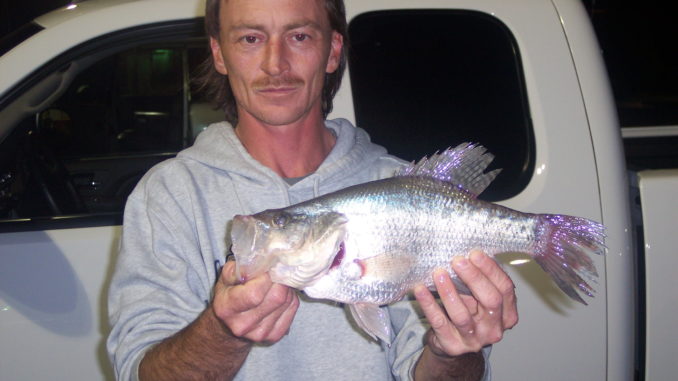
RALEIGH, N.C. (Jan. 8) — Brian (Buck) Stikeleather of Stony Point broke the white crappie state record on Dec. 9 after reeling in a 1-pound, 13-ounce fish from Lake Norman.
Stikeleather caught the latest record-breaker, which measured 15½” in length, using a Shakespeare Outcast rod, Quantum Icon reel and, on a 6-pound test line, a Bass Assassin lure — the same lure Eddie Braswell, the previous record-holder, used when he reeled in his 1-pound, 8-ounce fish on Aug. 15.
In fact, Stikeleather credits a picture he saw of Braswell holding his record-setting fish as his inspiration to try his luck at a state record.
“I saw a picture of the recent record-breaker in the magazine and I said to myself, ‘I’ve caught white crappie at least that big, if not bigger’,” Stikeleather said. “Heck, I’ve probably eaten a bunch of records!”
While the ratio of black crappie to white crappie is about 10 to one, Lake Norman does boast a lot of nicely sized crappie of both species, particularly in the upper end of the lake, above Hwy. 150, according to Kin Hodges, Commission fisheries biologist.
“We’ve never come across any in our samples that were as large as Mr. Stikeleather’s, but on average, the crappie in Norman are larger than in any of the other lakes that we sample, such as Hickory, Lookout Shoals, Belews, W. Kerr Scott and Salem,” Hodges said. “In our most recent sample, about 90 percent of the crappie we collected were larger than 8 inches, which is the size limit for Norman.”
Cool weather fishermen angling for a white crappie state record need to hit the lake now. According to Hodges, the cooler months are the best for catching crappie because the fish tend to school together and hang out around deep water structure. Stikeleather said he caught his state record in 36 feet of water.
In the warmer months, white crappie are more scattered and harder to catch.
The record-breaking fish was weighed on certified scales at Wayne Mays Meat Processing in Taylorsville. Kevin Hining, a fisheries biologist, verified the catch.
To qualify for a state record, anglers must have caught the fish on a hook and line, have the fish weighed on a certified scale witnessed by one observer, have the fish positively identified by a fisheries biologist from the Commission and submit an application with a full, side-view photo of the fish.
For a list of all freshwater fish state records in North Carolina or more information on the State Record Fish Program, visit the Commission’s Web site, www.ncwildlife.org.




Be the first to comment